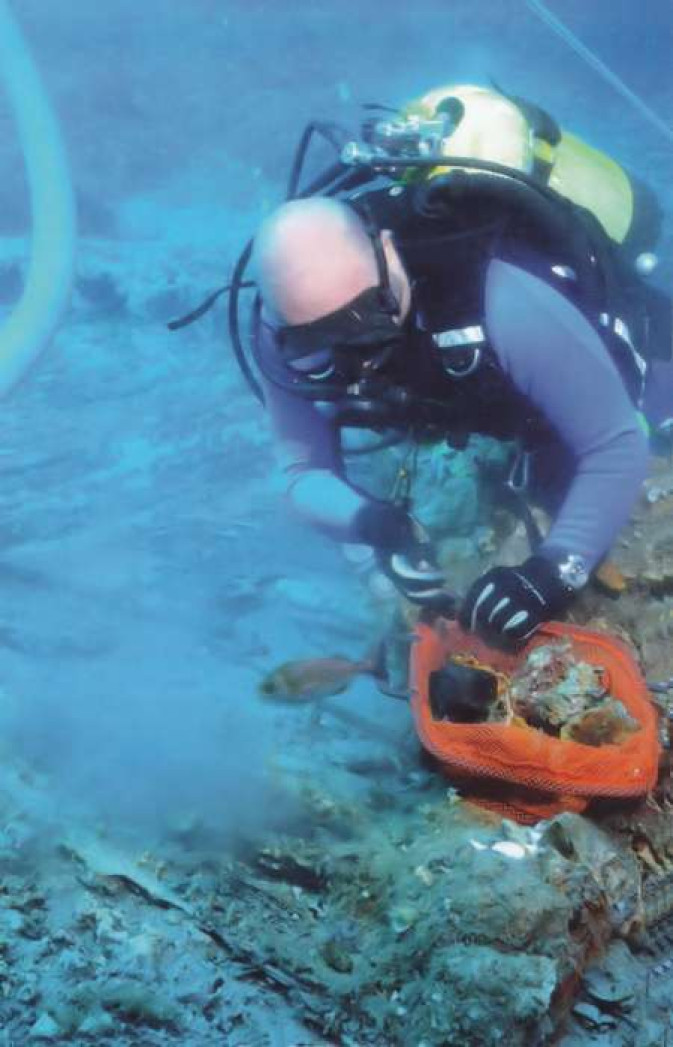The Kythera Adventure. November/December 2011 ODYSSEY pp. 18-19
Photograph: Scraping the bottom divers worked collecting artifacts which they hope will shed more light on the ship and its voyage.
In 1802, one of the ships charted by Lord Elgin to transport the Parthenon Marbles to England sank off the coast of the southern Peloponnese. Most of its cargo was recovered but a Greek Australian foundation and the Hellenic Ministry of Culture have joined in a new salvage mission they hope will yield vital information about the ship as well as its cargo.
By Mary Sinanidis
Last July, a team of underwater archaeologists spent two weeks diving off the coast of Avlemonas, southwest of the island of Kythera. Their mission? To examine the shipwreck of the Mentor that sunk in the early hours of September 17, 1802, as it transported marbles from the Parthenon to London via Malta.
The story of the Parthenon Marbles - muggled out of Greece by Thomas Bruce, the 7th Earl of Elgin and British ambassador to the Ottoman Empire from 1799 to 1803 - and the ensuing controversy concerning their ownership is notorious. Few people, however, are aware of the details of their transport conditions.
Archaeological enthusiast, John Fardoulis, spokesperson of the Sydney-based Kytherian Research Foundation (KRG) that funded the expedition headed by the Hellenic Ephorate of Underwater Antiquities, says that few people are aware of the Mentor's sinking and its valuable cargo consisting of seventeen crates. He jokes that the god Poseidon may have had something to do with it to stop the marbles from leaving Greece.
The Mentor disaster, apart from having the trappings of an Odyssean tale, showcases a very embarrassing moment of the ongoing adventure of the Parthenon marbles. "lt provides a historical link to the Parthenon, socio-political influences at the time, and the history of maritime trade and shipping," says Fardoulis, who sees the shipwreck as a "time capsule".
The ship, a brig built in i 780, and it's eight-member crew set sail from Piraeus. But the notoriously strong winds at Cape Tainaro blew the ship off course before it finally rammed into rocks at Avlemonas. The crew survived, although the Mentor's precious cargo was trapped in the wreckage for two years. Lord Elgin paid exorbitant amounts to Kalymnos sponge divers, who could reach depths of over twenty metres, in an effort to salvage marbles from the sea bed.
Most of the cargo was recovered-at a cost. Some believe that the two-and-a-half-year salvage project may be partly responsible for Elgin's financial ruin which, in turn, led to his decision to sell the Parthenon Marbles to the British Museum in 1816 at what's been acknowledged as a very low price.
The Mentor's story doesn't end with Elgin. In 1975, the French sea explorer Jacques-Yves Costeau personally headed a mission to locate and examine the wreck. More dives followed, this time conducted by the Institute of Under"water Antiquities Research in 1980 and the Hellenic Ephorate of Underwater Antiquities in 2009. They all failed to recover or identify any pieces of statuary or marbles.
These unsuccessful missions did not discourage Dr Dimitris Kourkoumelis. In July, he led new, a ten- member salvage mission of the Underwater Antiquities Ephorate to explore the shipwreck in hopes that new technologies, techniques, and other resources might yield results. "We used a device called an airlift to excavate, a bit like a vacuum cleaner that removes sand/silt covering the wreck. It takes two days just to set it up properly," says Fardoulis. "We have a team that's focused on the project, prepared to dedicate the next few years in completing the research."
The team's optimism was rewarded. Three coins - two silver and one bronze-were recovered quite early, encouraging the team to probe further. "Finding ancient coins proves that other antiquities were being carried on the ship, not just crates of Parthenon marbles and sculptures," he says.
Also salvaged from the wreck were clay, glass, and porcelain tableware used by the Mentor's crew, two pistols, a cannonball, a compass and other items, including a clock showing the time of the ship's sinking. They also cleared a section of the wreck's shell, still in good condition. All these articles provide information on trade and navigation of the time.
"The early 1800s were a very interesting time for Greece and the Mediterranean, with power struggles between the Ottomans, French, Russians and British taking place. Piracy was also rife," says Fardoulis. "Finding a wide range of weapons on the Mentor shipwreck - a merchant vessel - helps remind us of how dangerous the Mediterranean was for shipping at the time." He states that this was highlighted by the many musket balls, two pistols and canon ball found as part of the wreck.
Findings are currently with the Ephorate of Underwater Antiquities, the body responsible for marine archaeology in Greece. Fardoulis hopes that the conserved artifacts might eventually be displayed in the New Acropolis Museum or in the Archaeological Museum of Kythera that has been closed for six years due to earthquake damage. Perhaps attention from the Mentor project will help reopen the island's museum, another of the Kytherian Research Group's goals.
"Kythera is a beautiful and relatively underdeveloped island tourist-wise, so an interesting story and inspiring imagery from the deep blue waters around the island will help increase Kythera's international profile," says Fardoulis, who adds that the excavation proves how people and foundations from the diaspora can help research take place in Greece. He notes the support of the Nicholas Anthony Aroney Trust and Kytherian Association of Australia that made this under-water excavation possible.
"Such efforts can lead to new chapters of history being written and shared around the world," he states, adding that this is just the beginning. "Key findings and conclusions will grow over time."
